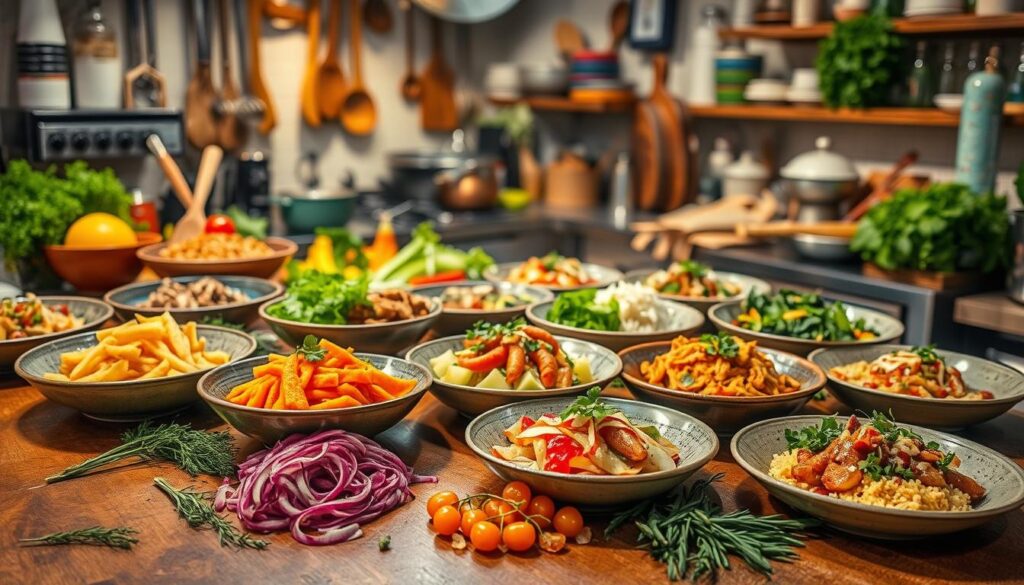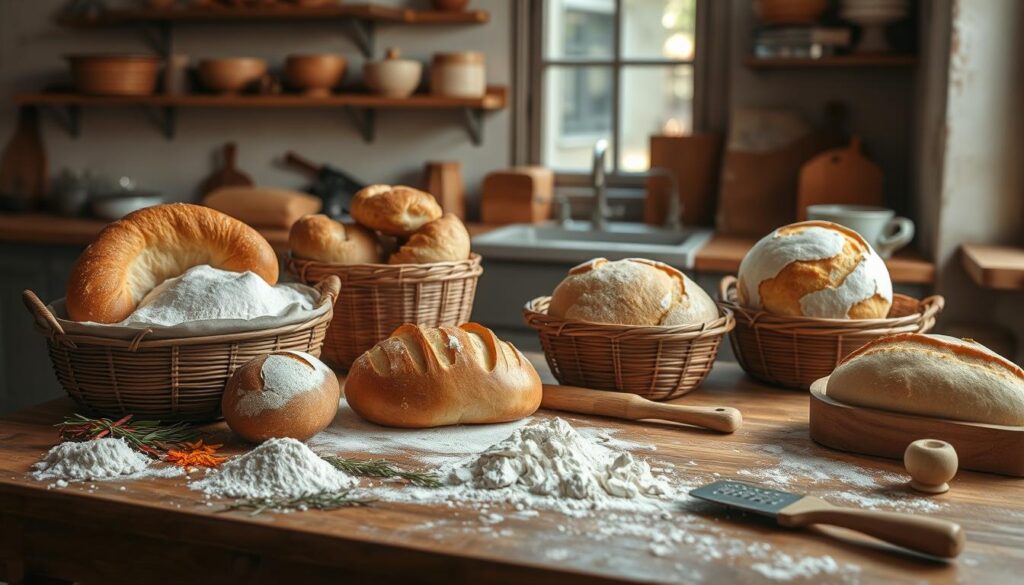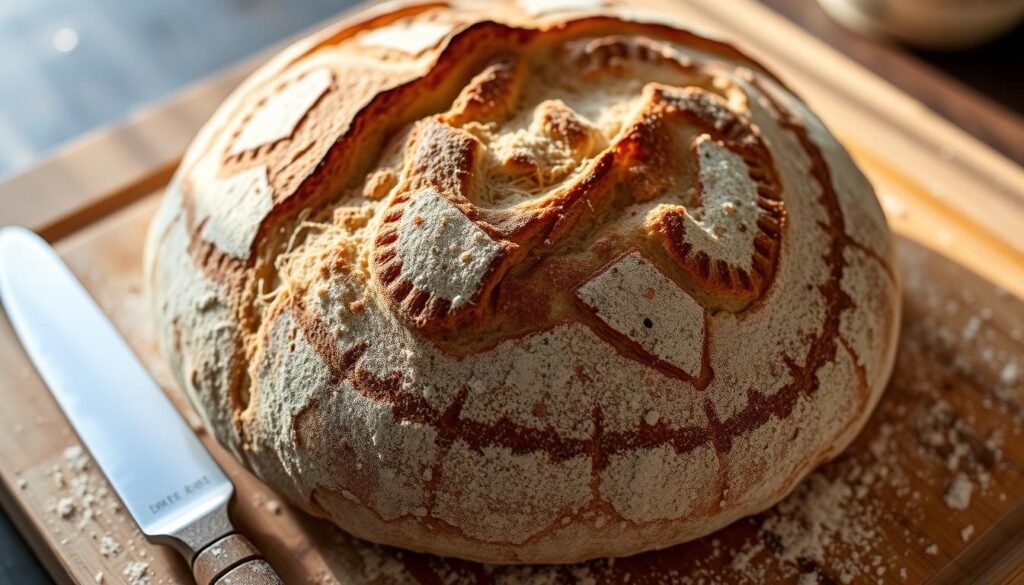The world of rising recipes is changing fast, exciting food lovers everywhere. It’s all about artisanal breadmaking and trying new leavening agents. This article will show you how to improve your baking skills and make delicious homemade breads and pastries.

Key Takeaways
- Discover the rise of artisanal breadmaking and the art of sourdough starters and fermentation
- Explore the versatility of ancient grains and flours in creating unique bread textures and flavors
- Master the art of proofing dough for perfect rise and texture
- Experiment with diverse yeast varieties to unlock new flavor profiles in your baked goods
- Dive into the world of enriched doughs and indulgent bread creations
The Rise of Artisanal Breadmaking
In the world of baking, a new era is beginning. Skilled artisans are bringing back old ways to make amazing artisan breads. They use sourdough starters and fermentation to create breads with deep flavors and textures.
Sourdough Starters and Fermentation
Sourdough starters are the key to these special artisan breads. They are grown with love and patience. The fermentation process adds a unique tang and makes the bread better for you, with more probiotics.
Exploring Ancient Grains and Flours
Bakers are now using ancient grains and flours to make unique breads. Grains like spelt and einkorn add new flavors and health benefits. Each grain has its own taste and nutritional value.
| Ancient Grain | Flavor Profile | Nutritional Benefits |
|---|---|---|
| Spelt | Nutty, slightly sweet | High in protein, fiber, and B vitamins |
| Einkorn | Robust, slightly earthy | Rich in antioxidants and nutrients |
| Emmer | Hearty, with a subtle nuttiness | High in protein and fiber |
By using artisan breads, sourdough starters, ancient grains, and flours, bakers are starting a new chapter in food. They are making food that delights the senses and is good for us.
Mastering the Art of Proofing Dough
Making the perfect loaf of bread is a delicate dance. Proofing dough is a critical step in this process. It allows the dough to rise and develop its unique flavors.
Proofing, or fermentation, lets the dough rest and rise at a warm temperature. The yeast eats the sugars, making carbon dioxide and alcohol. This makes the dough airy and adds to its complex flavors.
- Temperature control is crucial during proofing. The ideal temperature range is between 75-85°F. This helps the yeast thrive and the dough rise evenly.
- Humidity management is also important. Too much or too little moisture can affect the proofing process. A humidity level of 75-85% is often recommended for optimal results.
- The proofing time can vary based on the dough type and desired outcome. Longer proofing times, known as dough fermentation, can result in a more complex flavor profile.
By mastering proofing, bakers can create a wide range of breads. From light and airy sourdough to decadent enriched doughs. Understanding the science behind proofing methods and dough fermentation is key to consistently producing exceptional baked goods.
“The true craft of baking lies in the patient mastery of the proofing process. It’s where the magic happens.” – Julia Child, renowned chef and author
Embracing Yeast Varieties for Unique Flavors
In the world of artisanal breadmaking, finding unique flavors is all about exploring different yeast varieties. Bakers are moving beyond the usual commercial yeast. They’re diving into specialty yeasts, each with its own special traits. These yeasts can change the taste and texture of homemade breads.
Wild Yeast Cultivation Techniques
Wild yeast starters have become a favorite among passionate bakers. They use natural yeasts from the air, flour, and environment to create sourdough starters. These starters add complex, tangy, and satisfying flavors to breads.
Learning to cultivate wild yeast takes patience, experimentation, and a good understanding of fermentation. But the results are worth it.
Experimenting with Leavening Agents
Bakers are also trying new leavening agents to make unique breads. They use baking soda and baking powder, as well as natural agents like mead or kefir. This opens up endless possibilities for creative bread-making.
By exploring yeast varieties, wild yeast techniques, and leavening agents, bakers can discover a world of flavors. This takes their homemade breads to new levels of artistry and enjoyment.
rising recipes: New Frontiers in Bread Baking
In the world of bread baking, rising recipes are changing the game. They’re introducing new ways to shape and score bread. This is making the art of making artisanal bread exciting for everyone.
Bakers are now making bread into art. They’re using fancy shapes and designs. These breads are not just tasty, but also beautiful.
Scoring bread has also become more creative. Bakers use different tools to make cool designs. These designs make the bread look amazing and help it bake better.
| Innovative Bread Shaping Techniques | Unique Scoring Patterns |
|---|---|
|
|
Bakers are always finding new ways to make bread. rising recipes are becoming more interesting. They show the beauty of bread-making in a whole new way.
“The beauty of bread lies not just in its taste, but in the artistry and creativity that go into its creation.”

Enriched Doughs and Indulgent Creations
Get ready to dive into the world of enriched doughs. Here, butter, eggs, and other rich ingredients mix to make luxurious breads like brioche and challah. Learn the secrets and flavors that make these treats special, pleasing both your taste buds and soul.
Brioche, Challah, and Beyond
Brioche is a French bread known for its buttery taste and golden color. It’s made with lots of butter and eggs, giving it a soft inside and a shiny crust. Challah, a Jewish bread, is also rich, with a sweet taste and a pretty braid.
Bakers keep pushing the limits, mixing old ways with new tastes and ingredients. They make brioche with herbs and challah with chocolate. The world of enriched doughs is full of endless possibilities.
| Bread Type | Key Ingredients | Distinguishing Features |
|---|---|---|
| Brioche | Butter, eggs, sugar | Rich, buttery texture; golden-hued crumb |
| Challah | Eggs, honey, oil | Subtly sweet flavor; braided appearance |
| Enriched Dough Creations | Varied ingredients | Innovative flavors and textures |
Whether you’re an experienced baker or just starting, there’s so much to try. Explore the rich world of brioche, challah, and more. Every bite is a treat.
Exploring Global Bread Traditions
The world is full of global bread traditions, each with its own special flavors and shapes. These traditions have been passed down for generations. They tell stories of cultures and inspire new recipes.
From Northern Europe’s hearty rye breads to Ethiopia’s delicate injera, the world’s breads show our creativity and heritage. Let’s dive into these traditions and discover what makes them so loved.
Mastering the Art of Naan
In the Indian subcontinent, naan-making is an ancient art. This soft, tandoor-baked bread is perfect with curries and kebabs. It’s made with yeast, yogurt, and spices, creating a unique taste.
To make the perfect naan, bakers knead the dough and let it rise. Then, they slap it against a hot clay oven’s walls. This process gives naan its special texture and flavor.
The Enduring Legacy of Challah
Challah, a Jewish egg-based bread, has won hearts worldwide. Its golden crust and soft inside come from a detailed process. Challah is often braided into beautiful designs.
Challah is more than just delicious. It’s a symbol of Jewish celebrations, especially Shabbat. Its cultural importance is unmatched.
| Bread Tradition | Origin | Key Ingredients | Baking Method |
|---|---|---|---|
| Naan | India | Wheat flour, yogurt, yeast, butter | Tandoor oven |
| Challah | Jewish | Wheat flour, eggs, honey, yeast | Oven |
| Injera | Ethiopia | Teff flour, water | Flat griddle |
Exploring global bread traditions reveals stories and techniques. These traditions are more than just bread; they’re works of art. By embracing these traditions, we can create new recipes that honor our culinary heritage.
Baking Techniques for Perfect Crusts
Getting the perfect crust is key to making great bread. Whether you’re an experienced baker or just starting, learning baking techniques is vital. We’ll explore how to use steam and the role of oven management for the best crusts.
Mastering Steam and Oven Management
Adding steam to the oven changes the game for baking bread. It creates a moist space, helping the dough grow and get a shiny crust. It’s also important to manage the oven well. The right temperature and humidity are crucial for a great crust.
- Use a steam-injecting oven or make your own steam source to add moisture.
- Keep an eye on the oven temperature and adjust it for even baking and a golden crust.
- Try different baking times and temperatures to find what works best for your bread.
By getting good at using steam and oven management, you’ll make bread with a perfect crust. It will be crispy outside and soft inside.
“The secret to a perfect crust lies in the delicate balance of steam, temperature, and timing.”
The Art of Bread Scoring and Shaping
Learning to score and shape bread is key to making loaves that look great and taste even better. These skills make your baked goods not just pretty but also delicious. They affect the texture and flavor of your bread.
Scoring bread means making cuts on the dough’s surface. This helps it expand in a controlled way during baking. The cuts create a pattern that makes your bread stand out. You can choose simple or complex designs to change how your loaf looks.
Shaping bread is just as important. Bakers use kneading, folding, and shaping to make different bread forms. You can make a classic boule, an elegant batard, or even a braid. The way you shape your dough can turn a simple loaf into a masterpiece.
- Explore the tools and techniques used by master bakers to achieve precise and visually striking bread scoring patterns.
- Discover the importance of dough shaping in creating structurally sound and aesthetically pleasing loaves.
- Unlock the secrets to achieving the perfect crumb and crust through thoughtful bread scoring and shaping.
Mastering bread scoring and shaping will make your baked goods look amazing and taste even better. These techniques add creativity and precision to your breadmaking. They help you create loaves that are truly special.

“Bread scoring and shaping are the brushstrokes that transform a simple loaf into a culinary masterpiece.”
Sustainable Baking: Reducing Food Waste
The baking world is changing, moving towards sustainable practices. Bakers now focus on using every part of their ingredients. They find new uses for leftover dough and scraps.
Reducing food waste is a big part of sustainable baking. Bakers plan their ingredients carefully. They look for new uses for byproducts to cut down on waste.
- Utilizing every part of the ingredient: Bakers use fruit peels, vegetable trimmings, and spent grains in their recipes. This adds flavor and nutrition.
- Creative repurposing of leftover dough: Unused dough becomes crackers, breadcrumbs, or is frozen for later. This way, nothing is wasted.
- Exploring innovative uses for scraps: Bread crusts and scraps are turned into breadcrumbs, croutons, or used in savory fillings.
The sustainable baking movement also values local ingredients and supports small farmers. This helps reduce carbon emissions from long-distance transport. It also strengthens local communities.
| Sustainable Baking Practices | Benefits |
|---|---|
| Utilizing every part of the ingredient | Reduces food waste, adds depth of flavor and nutritional value |
| Creative repurposing of leftover dough | Prevents waste, allows for versatile use of resources |
| Exploring innovative uses for scraps | Transforms “waste” into valuable products, minimizes environmental impact |
| Sourcing local, high-quality ingredients | Supports local communities, reduces carbon footprint |
The baking industry is growing greener, reducing waste and inspiring eco-aware consumers. This shift towards sustainability is changing the way we bake and eat.
“Sustainable baking is not just about making delicious treats – it’s about respecting the resources we use and minimizing our impact on the planet.”
Conclusion
The world of rising recipes is always changing. Bakers and chefs are always trying new things. They explore new flavors and techniques.
Whether you’re new to baking or have been doing it for years, this article has something for you. It shows you how to improve your baking skills. You’ll learn about making artisanal bread and exploring different bread traditions from around the world.
Keep enjoying the process of trying new things in your kitchen. Share your baking with others. The world of rising recipes is full of possibilities, and there’s always more to discover.

